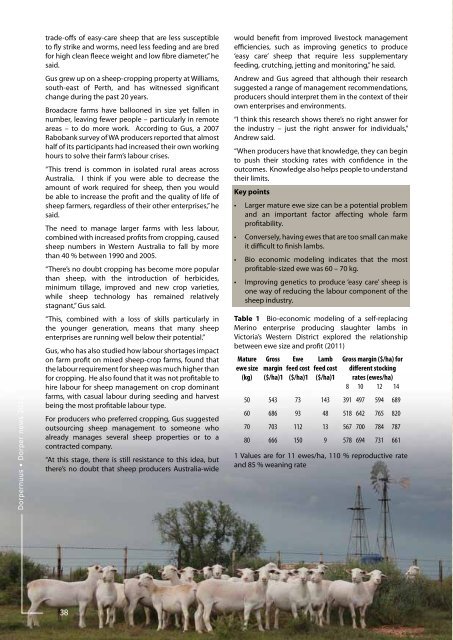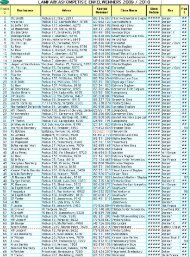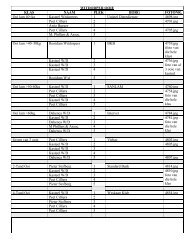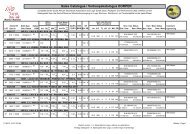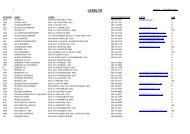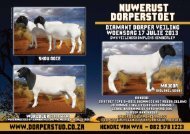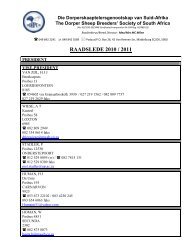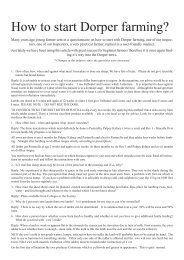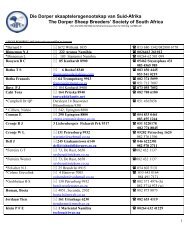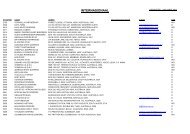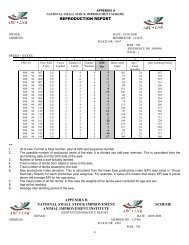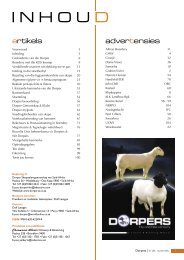D o rp e rn uus • D o rp ernews 2 0 1 2 - Dorper SA
D o rp e rn uus • D o rp ernews 2 0 1 2 - Dorper SA
D o rp e rn uus • D o rp ernews 2 0 1 2 - Dorper SA
You also want an ePaper? Increase the reach of your titles
YUMPU automatically turns print PDFs into web optimized ePapers that Google loves.
Do<strong>rp</strong>e<strong>rn</strong><strong>uus</strong> <strong>•</strong> Do<strong>rp</strong>er news 2012<br />
trade-offs of easy-care sheep that are less susceptible<br />
to fly strike and worms, need less feeding and are bred<br />
for high clean fleece weight and low fibre diameter,” he<br />
said.<br />
Gus grew up on a sheep-cropping property at Williams,<br />
south-east of Perth, and has witnessed significant<br />
change during the past 20 years.<br />
Broadacre farms have ballooned in size yet fallen in<br />
number, leaving fewer people – particularly in remote<br />
areas – to do more work. According to Gus, a 2007<br />
Rabobank survey of WA producers reported that almost<br />
half of its participants had increased their own working<br />
hours to solve their farm’s labour crises.<br />
“This trend is common in isolated rural areas across<br />
Australia. I think if you were able to decrease the<br />
amount of work required for sheep, then you would<br />
be able to increase the profit and the quality of life of<br />
sheep farmers, regardless of their other ente<strong>rp</strong>rises,” he<br />
said.<br />
The need to manage larger farms with less labour,<br />
combined with increased profits from cropping, caused<br />
sheep numbers in Weste<strong>rn</strong> Australia to fall by more<br />
than 40 % between 1990 and 2005.<br />
“There’s no doubt cropping has become more popular<br />
than sheep, with the introduction of herbicides,<br />
minimum tillage, improved and new crop varieties,<br />
while sheep technology has remained relatively<br />
stagnant,” Gus said.<br />
“This, combined with a loss of skills particularly in<br />
the younger generation, means that many sheep<br />
ente<strong>rp</strong>rises are running well below their potential.”<br />
Gus, who has also studied how labour shortages impact<br />
on farm profit on mixed sheep-crop farms, found that<br />
the labour requirement for sheep was much higher than<br />
for cropping. He also found that it was not profitable to<br />
hire labour for sheep management on crop dominant<br />
farms, with casual labour during seeding and harvest<br />
being the most profitable labour type.<br />
For producers who preferred cropping, Gus suggested<br />
outsourcing sheep management to someone who<br />
already manages several sheep properties or to a<br />
contracted company.<br />
“At this stage, there is still resistance to this idea, but<br />
there’s no doubt that sheep producers Australia-wide<br />
38<br />
would benefit from improved livestock management<br />
efficiencies, such as improving genetics to produce<br />
‘easy care’ sheep that require less supplementary<br />
feeding, crutching, jetting and monitoring,” he said.<br />
Andrew and Gus agreed that although their research<br />
suggested a range of management recommendations,<br />
producers should inte<strong>rp</strong>ret them in the context of their<br />
own ente<strong>rp</strong>rises and environments.<br />
“I think this research shows there’s no right answer for<br />
the industry – just the right answer for individuals,”<br />
Andrew said.<br />
“When producers have that knowledge, they can begin<br />
to push their stocking rates with confidence in the<br />
outcomes. Knowledge also helps people to understand<br />
their limits.<br />
Key points<br />
<strong>•</strong> Larger mature ewe size can be a potential problem<br />
and an important factor affecting whole farm<br />
profitability.<br />
<strong>•</strong> Conversely, having ewes that are too small can make<br />
it difficult to finish lambs.<br />
<strong>•</strong> Bio economic modeling indicates that the most<br />
profitable-sized ewe was 60 – 70 kg.<br />
<strong>•</strong> Improving genetics to produce ‘easy care’ sheep is<br />
one way of reducing the labour component of the<br />
sheep industry.<br />
Table 1 Bio-economic modeling of a self-replacing<br />
Merino ente<strong>rp</strong>rise producing slaughter lambs in<br />
Victoria’s Weste<strong>rn</strong> District explored the relationship<br />
between ewe size and profit (2011)<br />
Mature Gross Ewe Lamb Gross margin ($/ha) for<br />
ewe size margin feed cost feed cost different stocking<br />
(kg) ($/ha)1 ($/ha)1 ($/ha)1 rates (ewes/ha)<br />
8 10 12 14<br />
50 543 73 143 391 497 594 689<br />
60 686 93 48 518 642 765 820<br />
70 703 112 13 567 700 784 787<br />
80 666 150 9 578 694 731 661<br />
1 Values are for 11 ewes/ha, 110 % reproductive rate<br />
and 85 % weaning rate


